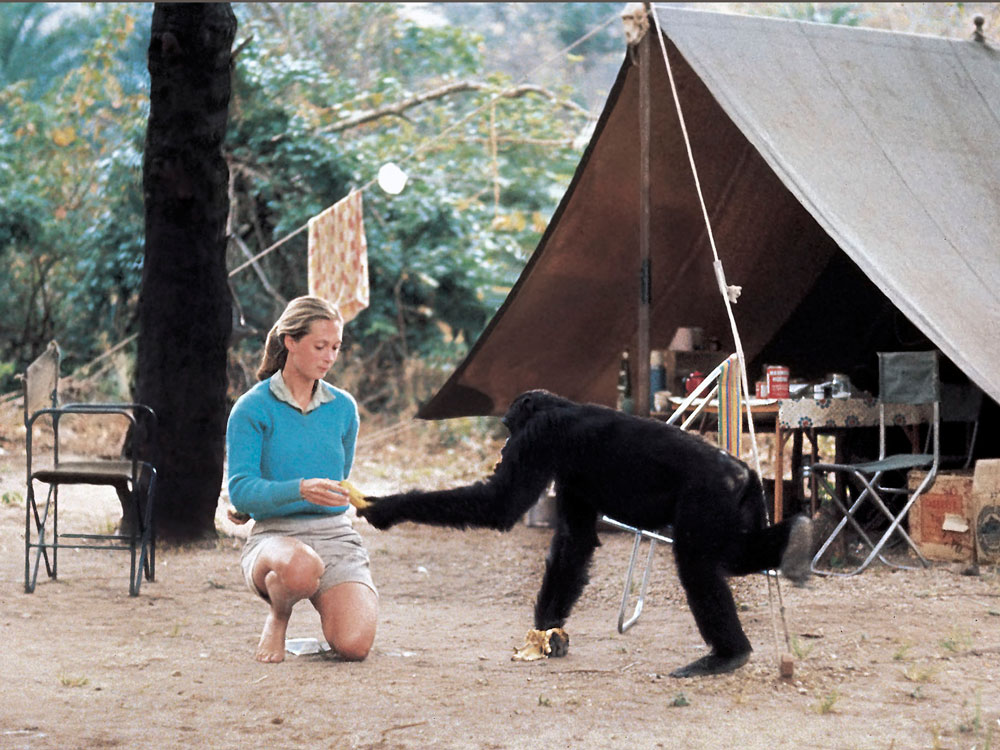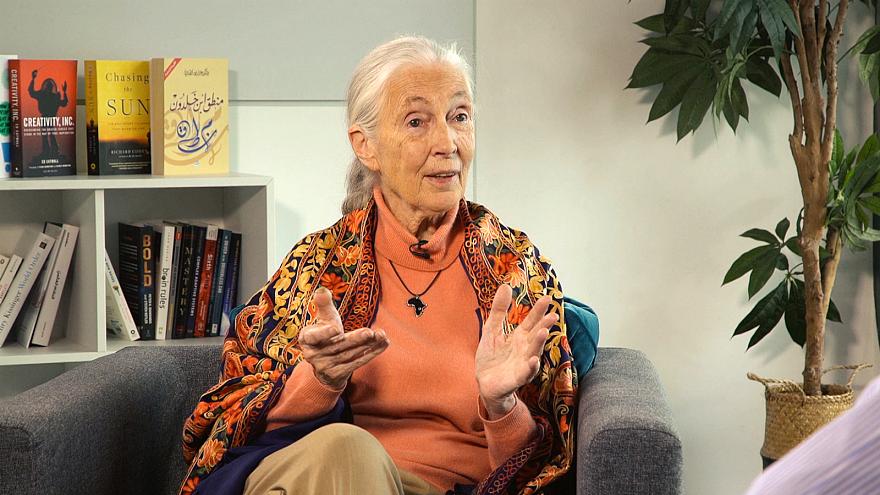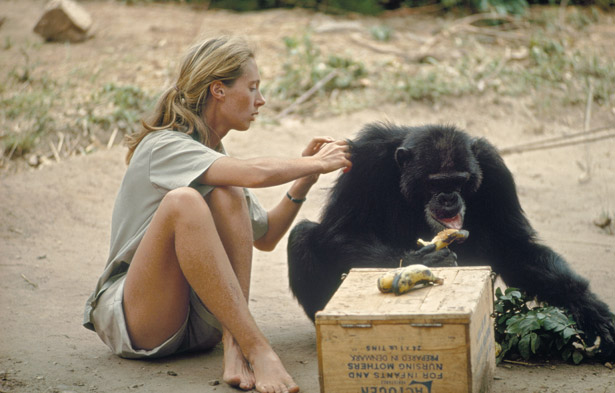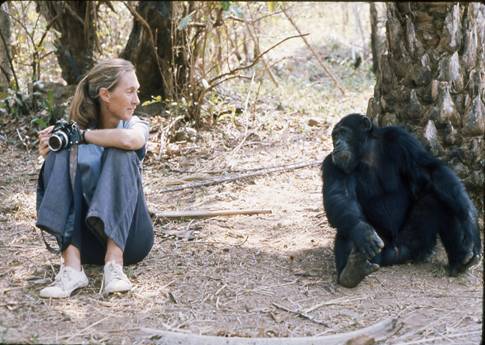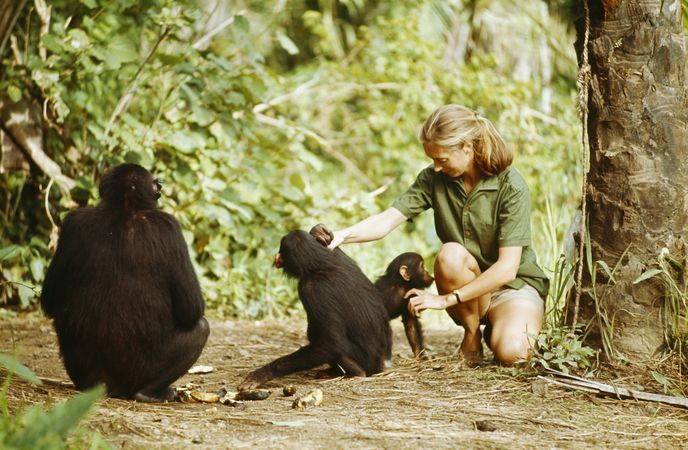Jane Goodall
Conservation's Mother Teressa
Dr Jane Goodall - a lifetime of studying chimpanzees
Researcher | Species champion | Field Biologist
Jane Goodall is a British primatologist, ethologist, anthropologist and UN Messenger of Peace. She is considered to be the world's foremost expert on chimpanzees and is best known for her 45-year study of social and family interactions of wild chimpanzees in Gombe Stream National Park, Tanzania. Jane was one of the first scientists to recognize complexity in animals and today considers herself an activist for both wildlife and the local communities that protect the world’s wild places. She is the founder of the Jane Goodall Institute and the Roots & Shoots program, and she has worked extensively on conservation and animal welfare issues.
Jane Goodall is very nearly a household name. Her tireless work around the globe speaking on behalf of wild animals, doing endless interviews wherever she goes keeps the profile of chimpanzees and other primates on our television screens and newspapers.
But what struck me most about Goodall, and the thing that younger generations could learn the most from, was her stubbornness. This doesn’t appear to be a characteristic acquired with age. Throughout her life, when Goodall has believed she’s right about something—the importance of animals, her campaign methods, the best location for a photo shoot—she is unshakeable. She doesn’t ignore changes in the world around her, like the shifts in activism or the worsening climate prognosis, but she also doesn’t allow them to undermine her drive. Goodall knows that would be fatal. “If you don't hope that your actions can make a difference, then you sink into apathy,” she told me. “If young people succumb to the doom and gloom—if they lose hope—that's the end.” - The Enduring Hope of Jane Goodall by Ciara Nugent, TIME magazine.
Wikipedia offers a very thorough look at her life - see Jane Goodall on Wikipedia
The difference in our human DNA and theirs is less than two per cent. They show emotions that are similar or identical to those that we call happiness, sadness, fear, despair and so on. Strong, affectionate and supportive bonds that develop among family members can last a lifetime of 60 years or more. They kiss, embrace, hold hands, pat one another on the back, swagger and shake their fists. - Jane Goodall quoted in an interview with The Ecologist
Valerie Jane Morris-Goodall was born in London. Her father, Mortimer Morris-Goodall, was a well-known race car driver. From early childhood, Jane was fascinated by all animals, an interest encouraged by her mother, Vanne. When Mortimer Morris-Goodall went to war, young Jane moved with her mother and younger sister, Judy, to live with her grandmother and aunts in the seaside town of Bournemouth, where they remained when her father and mother divorced following the war. A precocious reader in a family of women who encouraged intellectual accomplishment, Jane read everything she could get her hands on about wild animals and Africa. She did well in school despite an unusual neurological condition, known as prosopagnosia, which makes it difficult to recognize faces. Unable to afford a university education, she moved to London after school to work as a secretary for a documentary film company. When an opportunity arose to visit a friend’s family in Kenya, she returned to Bournemouth and worked as a waitress in a local hotel, living at home to save money for her trip.
In Kenya, Goodall was introduced to the legendary anthropologist Louis Leakey. Leakey hired her as an assistant and secretary, and she accompanied him and his wife Mary on an archeological dig at Olduvai Gorge. A leading authority on the evolution of man, Leakey knew there was a lack of hard data concerning the behavior of chimpanzees — our nearest evolutionary relatives — in the wild. Although Jane lacked scientific training, or even a college degree, she was eager to attempt the research herself. Despite Leakey’s confidence in her abilities, other experienced professionals did not believe a lone young woman from England could survive in the African bush. When the British colonial authorities refused to allow her to travel alone to the chimpanzee reserve near Lake Tanganyika, she recruited her mother to stay with her. In the summer of 1960, Jane Goodall and her mother arrived at Gombe Stream Chimpanzee Reserve in what is now Tanzania. At first the Gombe chimps fled at the sight of a human intruder, and Goodall could only observe them from a distance through binoculars. Over the months that followed, she gradually won the trust of a single male chimpanzee she named David Graybeard.Her habit of giving the chimps human names was a sharp departure from established practice, which dictated that animals be given numbers, not names. It was believed that the numbering system prevented researchers from investing the animals with human emotions, but Goodall believed that understanding animal behavior requires the observer to see animals as individuals, rather than interchangeable specimens. In fact, she found the chimps in her study group to have widely divergent personalities and complex family relationships. Readers of her books have come to know many of the Gombe chimpanzees by name, including the high-ranking female known as Flo, her daughter Fifi, and Fifi’s ferocious son, Frodo.
Early in her stay at Gombe, Goodall observed David Graybeard and the band’s leader, Goliath, stripping the leaves from sticks to use them for collecting and eating termites. Although animals had been seen using objects as tools in the past, it was the first instance of an animal being observed altering an object for a practical purpose —in other words, toolmaking, an activity previously thought to be the defining characteristic of human beings. Goodall also observed chimps pursuing baboons and bush pigs together, an example of cooperative hunting, also thought to be uniquely human behavior.
In Tanzania, Goodall met Hugo van Lawick, a Dutch wildlife photographer and filmmaker. His photographs of Jane Goodall and the Gombe chimps in National Geographic magazine drew widespread attention to her work and helped win increased support for the research.
On the advice of Louis Leakey, Goodall returned to England to earn a doctorate in ethology, the science of animal behavior, at Cambridge University. In 1964, Goodall and Van Lawick were married in London. Her husband held the title of baron in the Netherlands; during their marriage, Jane Goodall was often referred to in the press and elsewhere as Baroness van Lawick. She received her doctorate from Darwin College, Cambridge, in 1965. The couple returned to Tanzania, where she established the Gombe Stream Research Centre.
Goodall’s discoveries gained an international audience when the National Geographic television program Miss Goodall and the Wild Chimpanzees was broadcast in 1965. Goodall and Van Lawick’s son, Hugo, known affectionately as “Grub,” was born in 1967. Following the example of the more well-adjusted chimps she had observed, Goodall remained in constant contact with her child for the first three years of his life. For much of the ’70s she promoted the lessons of primatology for successful child rearing. Jane Goodall and Hugo van Lawick divorced in 1974 but remained on good terms for the rest of Van Lawick’s life, collaborating on the documentary film People of the Forest.
In the 1970s, Dr. Goodall began to observe a darker side of chimpanzee life, including a four-year war between two bands of chimps, marked by extreme savagery and acts of cannibalism. Her field research suggests that the aggressive and warlike behavior of humans is deeply rooted in our primate ancestry. Goodall and her allies had long advocated the creation of a national park in Gombe. In the course of this work she met the director of Tanzania’s national park system, Derek Bryceson. The British-born Bryceson was a Royal Air Force veteran who had settled in Tanzania after World War II. A supporter of Tanzanian independence, he was elected to the new country’s National Assembly. Bryceson was profoundly impressed by Goodall’s presentation to the National Assembly. She was moved by his courage in overcoming injuries sustained when he was shot down over Egypt during World War II. Sharing their love for the treasures of Tanzania’s wildlife, Goodall and Bryceson were married in 1975 and made their home at Lake Tanganyika until his death in 1980.In 1977, Goodall founded the Jane Goodall Institute for Wildlife Research, Education and Conservation. While the Institute initially focused on supporting continued field research on wild chimpanzees, its work has expanded to promoting the power of individuals to protect the environment for all living things. As of this writing, the Goodall Institute has 19 offices around the world, operating community-centered conservation and development programs, principally in Africa. Jane Goodall later founded a youth program, Roots and Shoots, which now operates in over 130 countries.
For many years, Jane Goodall has been an outspoken opponent of the use of chimpanzees in medical research, and has campaigned for the more humane treatment of research animals when their use cannot be done away with altogether. Other dangers to the world’s chimpanzees include the erosion of their natural habitat through careless development, and the hunting of wild chimpanzees for the luxury “bush meat” trade. Her fight to preserve the world’s chimpanzee population has included service on the board of the world’s largest chimpanzee sanctuary, Save the Chimps, in Fort Pierce, Florida.
Dr. Goodall has received numerous international honors, including the Medal of Tanzania, the National Geographic Society’s Hubbard Medal, the Kyoto Prize of Japan, the Prince of Asturias Award for Technical and Scientific Research, the Benjamin Franklin Medal in Life Science, and the Gandhi/King Award for Nonviolence. In 2002 the United Nations named her a Messenger of Peace. In a 2004 ceremony at Buckingham Palace, Queen Elizabeth II conferred on Dr. Goodall the title of Dame of the British Empire, equivalent to a knighthood.
For 45 years, Jane Goodall continued her firsthand observation of the chimpanzees at Gombe, gaining constant insight into the variety of their social behavior, ranging from senseless cruelty to extreme tenderness. As late as 1987, she observed an adolescent chimpanzee adopt a three-year-old orphan who was not a close relative, a demonstration of altruism that was long thought to be beyond the capacity of animals. The essence of her scientific work appears in her book The Chimpanzees of Gombe: Patterns of Behavior, the definitive work on the behavior of chimpanzees. Her work forms the core body of knowledge on social learning among chimpanzees. It helped differentiate chimpanzees from a related species, the bonobo, and led to the classification of chimps, bonobos and gorillas — alongside human beings — as hominids.
Dr. Goodall has shared her findings with the general public in a series of highly readable books, including My Friends the Wild Chimpanzees, In the Shadow of Man and Through a Window. She has also written a number of books for children, including Grub: The Bush Baby, Chimpanzees I Love and My Life with the Chimpanzees. A vast audience has learned of her work through a series of National Geographic television programs and the IMAX film, Jane Goodall’s Wild Chimpanzees. Her other books include two volumes of memoirs and a spiritual autobiography, Reason for Hope, in which she discusses her religious beliefs and her faith in the future of humankind. A more recent work is Harvest for Hope: A Guide to Mindful Eating (2005), in which she encourages her readers to weigh the moral and environmental implications of their dietary choices. Although Jane Goodall’s discovery of group violence among chimpanzees suggests that aggressive behavior is deeply rooted in our evolutionary past, her observations of kindness and selfless behavior among the chimps of Gombe show that these traits too are part of our evolutionary heritage. She maintains our ability to reason and learn from shared experience will yet enable us to preserve a livable environment for ourselves and all our fellow creatures. Today, Jane Goodall travels nearly 300 days a year, circling the globe to share her message of hope, and encouraging young people to work for a better world.
Courtesey: Academy of Achievment - Jane Goodall, Internationally Acclaimed Primate Researcher
ARTICLES OF INTEREST:
Go back to: Researchers & Species Experts
PUBLICATIONS
- 1969 My Friends the Wild Chimpanzees: National Geographic Society.
- 1971 Innocent Killers (with H. van Lawick). - 1971 In the Shadow of Man: Published in 48 languages. - 1986 The Chimpanzees of Gombe: Patterns of Behavior. The Wildlife Society (USA) Award for "Outstanding Publication in Wildlife Ecology and Management". - 1990 Through a Window: 30 years observing the Gombe chimpanzees. Translated into more than 15 languages. American Library Association "Best" list among Nine Notable Books (Nonfiction) for 1991. - 1991 Visions of Caliban (co-authored with Dale Peterson, PhD). New York Times "Notable Book" for 1993. Library Journal "Best Sci-Tech Book" for 1993. - 1999 Brutal Kinship (with Michael Nichols). - 1999 Reason For Hope; A Spiritual Journey (with Phillip Berman). Translated into Japanese and Portuguese. - 2000 40 Years At Gombe: Stewart, Tabori, and Chang. - 2000 Africa In My Blood (edited by Dale Peterson): Houghton Mifflin Company. - 2001 Beyond Innocence: An Autobiography in Letters, the later years (edited by Dale Peterson): Houghton Mifflin Company. ISBN 0-618-12520-5 Online version. - 2002 The Ten Trusts: What We Must Do To Care for the Animals We Love (with Marc Bekoff): Harper San Francisco. - 2005 Harvest for Hope: A Guide to Mindful Eating: Warner Books, Inc. ISBN 0-446-53362-9 - 2009 Hope for Animals and Their World: How Endangered Species Are Being Rescued from the Brink: Grand Central Publishing ISBN 0-446-58177-1 - 2013 Seeds of Hope: Wisdom and Wonder from the World of Plants (with Gail Hudson): Grand Central Publishing ISBN 1-455-51322-9Courtesey: Wikipedia
